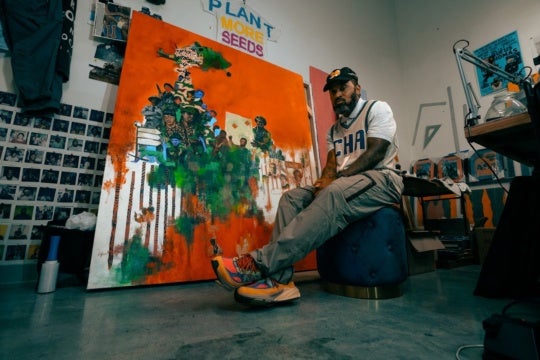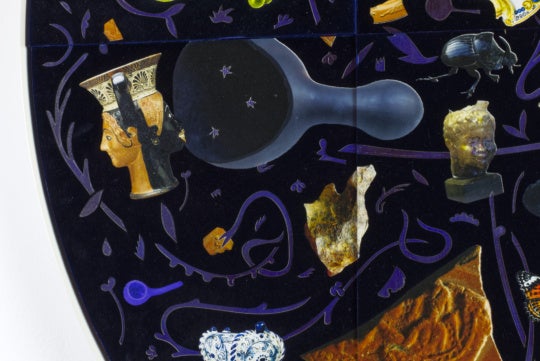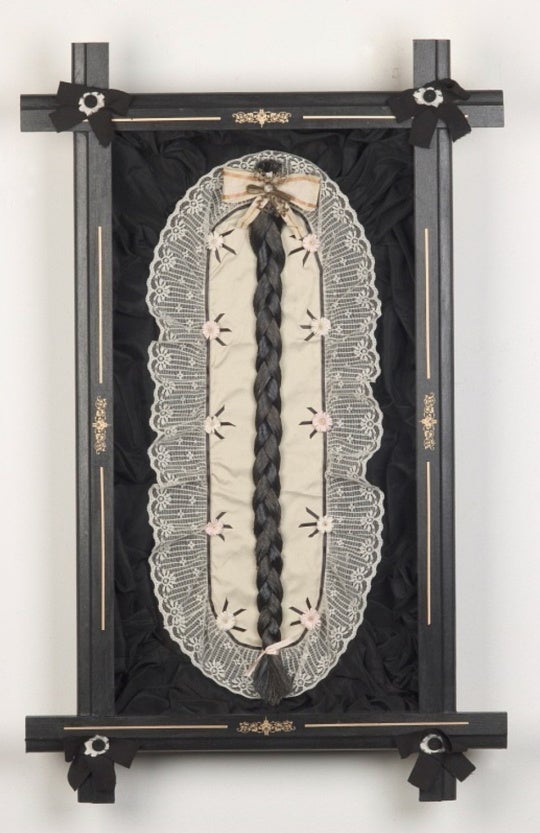
According to Merriam-Webster, the definition of the word “geometry” is as follows: mathematics concerned with the properties and relations of points, lines, surfaces, solids, and higher dimensional analogs. Replace “mathematics” with “art,” and you have the description of Nashville-based artist Kit Reuther’s new exhibition “Weights and Modules,” on view at David Lusk Gallery in Nashville through October 8. “Weights and Modules” comprises two- and three-dimensional works whose assortment fulfills the title’s promise.
“Titles are not always specific; they come at the end of the process when I’m surveying the works as a group,” Reuther explains. “I recognized the imagery in the paintings was weighted to the bottom edge of the canvases, but I liked the idea of a module—a nonorganic square, new and fresh.” Together, they appear complementary and express Reuther’s lifelong fascination with the intersections and interactions of lines, planes, curves, and edges. Each work seemingly completes the next as the mind’s eye attempts to connect these various elements like puzzle pieces created for a larger whole.

Reuther’s March 2016 exhibition at Lusk’s Memphis location was her first to incorporate a sizable three-dimensional work and served as the springboard for the Nashville show. She doesn’t pick favorites when it comes to medium, though. “I’ve been painting forever,” Reuther says, “but I began experimenting with three-dimensional works just seven or eight years ago. I love making objects that exist in space as equally as flat paintings on a wall.” She says she misses sculpture when she paints a lot, and vice versa. In her work, the spirit of each medium influences and appears in the other.
“Weights and Modules” features a total of eight oil-on-canvas paintings, measuring as large as 68 by 90 inches. They depict semicircles, cubes, triangles, and other geometric shapes in shades of predominantly white and gray. Reuther’s signature neutral color palette does not immediately convey warmth. “I am very aware of people looking at my work and thinking, Kit’s not a colorist,” Reuther admits, “but I do work within the realm of introverted color.” The nuances of ochre-, red-, and blue-tinged whites pop upon close examination, and a silver border in one painting integrates the metallic luster of a nearby boulder-like form. One painting includes a large section of muted green. The subtlety of these shifts in color creates a sense of balance against the otherwise neutral palette. Reuther carefully considers the many options presented by warm and cool tones, keeping an overall temperature in mind for any given painting, which can go sterile quickly when you work primarily in whites and grays. At the same time, Reuther claims, “I am never opposed to grabbing a can of neon spray paint in reaction to the neutral when I need to shake up my approach.”

One of three modular sculptures, for example, conceals strips of neon orange on the floor-facing edges of its rectangular units, which appear to emit a faint glow in the units’ shadows and on the sculpture’s limestone base. These orderly stacks of vertical mass, collectively a system of right and obtuse angles in black and white, not only introduce us to Reuther’s bold use of color but also to her rigorous studio practice. The industrial quality of nearly everything she touches has deep roots. Though Reuther studied interior design in college, her only training in sculpture was as a child from her dad, a pilot who restored vintage aircraft and who used the same power tools she uses today.
The three modular sculptures and the boulder greeting visitors at the main gallery entrance were all designed and fabricated by Reuther in cardboard, then cast in hollow sheet metal by Fort Houston. Reuther and the foundry fine-tuned the frameworks, examining joints and shaving down sharp edges, creating a final product that appears ambiguously perfect and imperfect, both machine-made and hand-crafted. Reuther describes the wooden open-air sculptures in the next gallery as “three-dimensional line drawings” and “boulders without the middle.”

Reuther lives in a gray and white world where her internal monologue of self-criticism and editing runs amok. Her interior design background instilled in her a healthy respect of how humans live, move through space, and live around space-occupying objects. “I believe in minimalism: few things, but each well curated,” she says. “What can I live without? When you control the physicality of your environment, you see the few things you have with more clarity and gratitude. What you’re immediately working on is the only thing distracting you.” This is the philosophy of an artist who values order over chaos, the experiential over the material, and editing over excess.
“Your best work comes when you un-learn the ‘right way’—that thing that holds you back,” Reuther imparts. At every step of the creative process, Reuther strives to push outside her comfort zone. Tired of self-imposed rules, she intentionally circumvents what people expect and is okay with doing things “wrong” if that brings a more compelling result. “Weights and Modules” demonstrates that for all the satisfaction supplied by a painting or sculpture’s perfect edges, angles, and coloration, it is lacking character before the artist’s touch is revealed. When forms are reduced to the degree that they are in “Weights and Modules,” the “dirtying up” of a work’s surface reminds us that the human hand has been there working.
Elaine Slayton Akin is an arts writer and nonprofit professional in Nashville by way of Little Rock. She works at the Frist Center for the Visual Arts and is a member of the Inter-Museum Council of Nashville. Her writing has been featured in Nashville Arts, Arkansas Life, Number, and At Home in Arkansas magazines.




